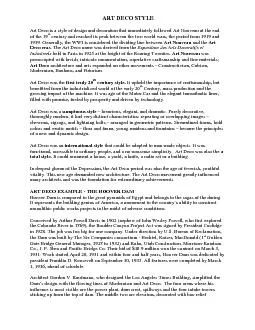

panels The five basreliefs on the Nevada elevator tower depict the multipurpose benefits of Hoover Dam flood control navigation irrigation water storage and powerHoover Dam is a National Historic ID: 827627
Download Pdf The PPT/PDF document "ART DECO STYLEArt Deco is a style of des..." is the property of its rightful owner. Permission is granted to download and print the materials on this web site for personal, non-commercial use only, and to display it on your personal computer provided you do not modify the materials and that you retain all copyright notices contained in the materials. By downloading content from our website, you accept the terms of this agreement.
ART DECO STYLEArt Deco is a style of des
ART DECO STYLEArt Deco is a style of design and decoration that immediately followed Art Nouveau at the end of the 19century and reached its peak between the two world wars, the period from 1919 and 1939. Generally, the WWIis considered the dividing line between Art Nouveauand the Art Deco eras. The Art Deco name was derived from the Exposition des Arts Decoratifs et Industrielsheld in panels. The five basreliefs on the Nevada elevator tower depict the multipurpose benefits of Hoover Dam flood control, navigation, irrigation, water storage and power.Hoover Dam is a National Historic Landmark and was named by the American Society of Civil Engineers as one of America’sSeven wonders of Modern Civil Engineering Wonders, along with two other iconic Art Deco structures the Empire State Buildingand the Golden Gate Bridge,which became the symbol for San Francisco and California. ART DECO THE GOLDEN GATE BRIDGEChief Engineer Joseph B. Strauss’ original 1922 Bridge design called for a hybrid cantilever and suspension structure across the Golden Gate. His initial plan was generally regarded as unsightly and a far cry from the elegant, understated lines that define the Bridge today. In 1929, Consulting Engineer Leon S. Moisseiff theorized that a long span suspension bridge could cross the Gate. A suspension structure of this length had never been tried before. Moisseiff and Strauss began to refine a new design.Strauss sought out architects, signaling that the Bridge’s design would be a fusion of form and function. In 1929, renowned Chicago theater architect John Eberson introduced Art Deco ideas that were costly.
On recommendation of artist Maynard Dixo
On recommendation of artist Maynard Dixon in 1930, Strauss replaced Eberson with Irving Foster Morrow, who lacked Eberson’s national reputation, but knew local politics, landscape and art. An obscure San Franciscobased architect who designed houses, Irving Morrow was brought in very earlyin April 1930as consulting architect to design an architectural treatment for the Bridge. Strauss told Irving and his wife, Gertrude, to “make it beautiful.” They believed an architecture work should stand on its own, not reflect European or classical design. Morrow’s initial conceptual drawings were influenced by Maynard Dixon’s early renderings and vision for the Bridge. In charcoal drawings, he freely refined and translated his vision into architecture terms.By mid1930, Morrow had eliminated the mechanical look of Strauss’ earlier designs, in favor ofsleek, modern, simple, lightweight towers and artfully curved cables. Angular forms of the concrete pylons marked the entrance to the Bridge and set the stage for the view of the towers. The towers’ improved design emphasized the towers’ soaring height. As the four rectangular tower portals decreased in width, the steppedback towers rose ladderlike from the roadway and ascended into the skyHe embellished the towers by adding wide, vertical fluting stamped into the steelplatted housings covering the horizontal bracing struts between the two tower legs. Their stylized geometry in the era's Art Deco style caught the sun's light on the structure, creating dramatic, changing shadows. Morrow designed and introduced small features like streamlined, angled
light standards,pedestrian walkways, an
light standards,pedestrian walkways, and uncluttered bridge railings to allow motorists and pedestrians an unobstructed view of the Bay and ocean.Irving Morrow was responsible for the iconic features and architectural enhancements which define the Golden Gate Bridge's Art Deco form. These are admired the world over and contribute to people's view of thebridge as a sculpture.Morrow undertook the great task of designing the lighting system that lighted the bridge. Two important factors came into play when considering the type and style of lighting desired for the bridge: the enormous size of the project and the tremendous scale and dignity of the project (Thoma). "Because of the Bridge’s great size, Morrow did not want the same intensity of light on all of its parts. The effect would seem too artificial. The towers, for example, were to have less light at the top so they would seem to soar beyond the range of illumination" (Thoma). He believed flashy lighting would distract from the structure’s magnificence so he selected low pressure sodium vapor lamps, that gave off a subtle amber glow, to line the roadway. These original low pressure sodium roadway lights were replaced with highpressure sodium vapor lamps 45 years later. Plastic amber lens were added to preserve the original warm glow. Unfortunately, due to a lack of funds, the tower lighting was not installed during the building of the bridge. Not until the bridge’s 50anniversary were lights installed, accenting the great height of the towers. Pacific Gas & Electric Company funded much of the money needed for the tower lighting, which cost $1.2 millio